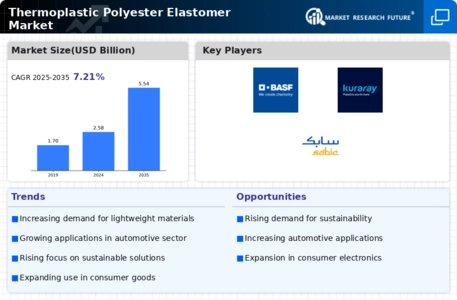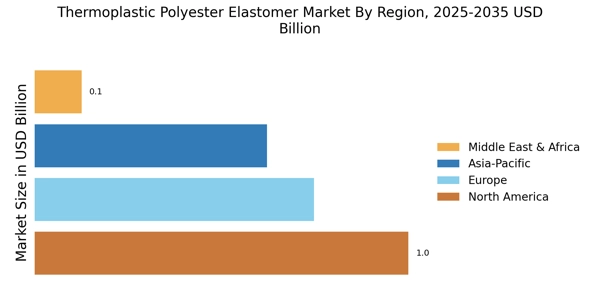Growth in Medical Applications
The Thermoplastic Polyester Elastomer Market is poised for growth in the medical applications segment, driven by the increasing demand for biocompatible materials. As healthcare providers and manufacturers seek innovative solutions for medical devices, thermoplastic polyester elastomers offer a unique combination of flexibility, durability, and safety. In 2025, the medical sector is projected to contribute significantly to the overall market, with applications ranging from surgical devices to drug delivery systems. The ability of thermoplastic polyester elastomers to be sterilized and molded into complex shapes makes them particularly suitable for various medical applications. This trend indicates a growing recognition of the material's potential in enhancing patient care and improving medical outcomes.
Expansion in Consumer Goods Sector
The Thermoplastic Polyester Elastomer Market is witnessing considerable expansion within the consumer goods sector. This trend is primarily driven by the increasing consumer preference for durable and flexible materials in products such as footwear, sporting goods, and household items. The market for thermoplastic polyester elastomers is expected to grow as manufacturers leverage their unique properties, including elasticity and resistance to wear and tear. In 2025, the consumer goods segment is anticipated to represent a substantial portion of the overall market, as brands prioritize product longevity and performance. Additionally, the ability to customize thermoplastic polyester elastomers for specific applications enhances their appeal, potentially leading to increased adoption across various consumer goods categories.
Increasing Focus on Sustainability
The Thermoplastic Polyester Elastomer Market is increasingly influenced by a growing focus on sustainability. As consumers and businesses alike prioritize environmentally friendly products, the demand for thermoplastic polyester elastomers, which can be produced from renewable resources, is likely to rise. In 2025, sustainability initiatives are expected to play a crucial role in shaping market dynamics, as companies strive to reduce their carbon footprint and enhance their corporate social responsibility. The development of bio-based thermoplastic polyester elastomers is indicative of this trend, as manufacturers seek to align their offerings with consumer expectations for sustainable materials. This shift towards sustainability not only enhances brand reputation but also opens new avenues for growth within the thermoplastic polyester elastomer market.
Rising Demand in Automotive Applications
The Thermoplastic Polyester Elastomer Market is experiencing a notable surge in demand, particularly within the automotive sector. This growth is largely attributed to the increasing need for lightweight materials that enhance fuel efficiency and reduce emissions. In 2025, the automotive industry is projected to account for a significant share of the thermoplastic polyester elastomer market, driven by the adoption of advanced materials in vehicle manufacturing. Furthermore, the versatility of thermoplastic polyester elastomers allows for their use in various automotive components, including seals, gaskets, and interior parts, which further propels market growth. As manufacturers seek to comply with stringent environmental regulations, the shift towards sustainable materials is likely to bolster the demand for thermoplastic polyester elastomers in automotive applications.
Technological Innovations in Manufacturing Processes
The Thermoplastic Polyester Elastomer Market is benefiting from ongoing technological innovations in manufacturing processes. Advances in production techniques, such as 3D printing and injection molding, are enabling manufacturers to create more complex and customized products with thermoplastic polyester elastomers. These innovations not only enhance production efficiency but also reduce waste, aligning with sustainability goals. In 2025, the impact of these technological advancements is expected to be profound, as companies increasingly adopt state-of-the-art manufacturing methods to meet the evolving demands of various industries. The ability to produce high-quality thermoplastic polyester elastomer products at a lower cost may further stimulate market growth, as manufacturers seek competitive advantages in a rapidly changing landscape.


















Leave a Comment